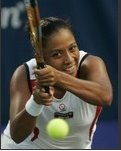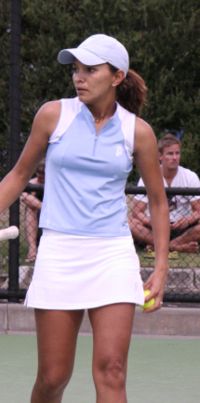September Wednesday Coaches Corner: Davis Cup Captain Arthur Ashe
Wednesday, September 3, 2008
 With the second week of the 2008 U.S. Open underway and the semifinal weekend of Davis Cup play coming up on September 19, I thought it appropriate to reflect on someone who holds great significance to both, Arthur Ashe.
With the second week of the 2008 U.S. Open underway and the semifinal weekend of Davis Cup play coming up on September 19, I thought it appropriate to reflect on someone who holds great significance to both, Arthur Ashe.
When I think of Arthur Ashe I always think of his humanity first and foremost, rarely do I even associate him with Davis Cup play, but that is a significant area of his tennis legacy. I have compiled related data from different sources to take a look at his coaching role as Davis Cup Captain.
Days of Grace
Excerpt from "Arthur Ashe: A Biography" By Richard Steins
Arthur Ashe had played his last Davis Cup match in 1978. His heart operation and his retirement from active tennis play in 1980, however, did not diminish his love for the Davis Cup tradition. Just a few months after his surgery, Arthur was offered the opportunity of a lifetime. While attending the U.S. Open in New York, he was approached by Marvin P. Richmond, the incoming president of the U.S. Tennis Association (USTA; formerly the USLTA). Richmond told Arthur that Tony Trabert, a former tennis champion and current captain of the U.S. Davis Cup team, wanted to resign. Richmond wanted Ashe to replace Trabert. Trabert, one of the great tennis champions a generation older than Arthur, had been captain of the team since 1976 and had presided over victories against Great Britain in 1978 (in which Arthur had played) and Italy in 1979.
Arthur was ecstatic. This was a dream come true. The captaincy of his beloved Davis Cup team was exactly what he had hoped he could have. Now that he had been sidelined from active play, the Davis Cup team would be an excellent way to keep his hand in the game and to manage a team that represented his country in international play. Little did Arthur know that the adventure he was about to embark on would be, in his own words, "a disorganized, sometimes exhilarating, sometimes frustrating and even humiliating epic of victories and defeats, excitement and tedium, camaraderie and isolation."
In the early 1980's just as Arthur took over as captain of the team, the Davis Cup leadership decided to award prize money. In 1981, a Japanese company put up $1 million to sponsor the competition. In 1983 the NEC Corporation announced that it would donate $2.5 million to the Davis Cup.
Managing The "Bad Boys"
Tony Trabert wanted out as Davis Cup captain in 1980 because he was sick and tired of dealing with the younger players, in particular because of their self-centeredness, their rudeness on the court, and their willingness to challenge the rules and traditions of tennis. Trabert was known as a tough "law-and-order" man when it came to enforcing discipline on the team. He was the captain, and the team was expected to follow his orders. The fact that many team members bucked his leadership was a source of great frustration.
Arthur also considered himself a law-and-order person, as long as the rules were fair, which in tennis he believed they were. But he thought his management of the team might be smoother because he could relate more easily to the younger generation of players since he was closer to them in age. He would soon discover, however, that this was not to be the case in all instances, that the job of managing the "bad boys" of tennis would be one of the most challenging times of his life.
Arthur was also taking over as captain at a time when Davis Cup play was losing its appeal around the world as a spectator sport. Many top players, not just some Americans, declined to play in Davis Cup matches, and attendance at Davis Cup games had dwindled over the years. Arthur felt that he had a responsibility to help restore Davis Cup play to its former esteem. In many countries, the Davis Cup squad is selected by a committee. But in the United States, the captain chooses the team, or, at least, extends the invitation to top players to join.
In 1980, Arthur already had some of the best young players on his team. On of the most talented-and one with a notorious reputation for bad behavior on court-was John McEnroe. Already on his way to becoming one of the greatest tennis players of all time, McEnroe was deeply committed to Davis Cup play. Jimmy Connors, however, was not, but despite his tiff with Arthur in the mid-1970s over his the question of his patriotism, he could be convinced to play Davis Cup tennis, although his commitment was never really strong or consistent. He played a couple of Davis Cup matches in 1976 but had not been part of the team since then.
Soon after he took over as captain, however, Arthur had more on his mind than Connors. He had to assemble a team for a match against Mexico. For singles he had McEnroe and another fine player, Roscoe Tanner. His original doubles team, Stan Smith and Bob Lutz, was replaced by Marty Riessen and Sherwood Stewart after Smith developed an arm injury. McEnroe performed brilliantly, while the others on the team had their ups and downs. The United States won the games against Mexico, but the training sessions before the games and the games themselves were a quick initiation for Arthur into the difficulties of being captain. In dealing with the egos and demands of individuals who were used to being stars in their own right, having to "keep them happy" was not a part of the job Arthur particularly liked. But he had to do it, and true to his well-developed sense of duty, he did.
The 1981 quarterfinal matches wagainst the defending champion Czechoslovakia, were played in the National Tennis Center in Flushing Meadows, Queens, New York, and the were an example of all the complex problems and frustrations Arthur faced as captain of the Davis Cup team. Arthur had assembled the strongest team possible in addition to McEnroe, he had gotten the releuctant Connors to play, and Stan Smith and Bob Lutz were scheduled for the doubles match. The first match was between McEnroe and therising Czech superstar Ivan Lendl. More than 17,000 fans bought tickets to see the two young stars play each other. The Davis Cup matches were suddenly a hot ticket for tennis fans who previously had not been interested.
Excerpt from International Tennis Hall of Fame
...An amateur would never do so well again. As the last remaining pro, Okker got the $14,000 first prize while Ashe was happy to settle for $28 daily expenses for his historic triumph, the first major for a black since Althea Gibson's Forest Hills triumph a decade before. Ashe's victory also boosted American morale by ending the U.S. male championship drought that dated back 13 years to Tony Trabert's 1955 win.
That year Ashe was also a Davis Cup drought-buster, spearheading the U.S. drive to the sterling tub, last won five years before. He won 11 straight singles (the most in one campaign for an American) in the drive to retrieve the Cup from Australia. In the finale he beat Ray Ruffels easily on opening day, and, after the Cup was clinched by Bob Lutz and Stan Smith in doubles, Ashe finally gave way, losing to Bill Bowrey in a meaningless third-day match. The season closed with Ashe winning 10 of 22 tournaments on a 72-10 match record.
He would win both his singles in 1969 and 1970 as the U.S. successfully defended the Cup against Romania and then West Germany. In the latter his third day defeat of Christian Kuhnke, 6-8, 10-12, 9-7, 13-11, 6-4, was the longest match (86 games) in a Cup-deciding round. Eight years later he reappeared for a vital cameo that led to another Cup for the U.S.; his 6-2, 6-0, 7-5 singles victory over Kjell Johansson was the clincher over Sweden, 3-2, in the semifinal at Goteborg.
Ashe put in 10 years of Davis Cup, topped for the U.S. only by John McEnroe's 12 and Bill Tilden and Stan Smith's 11 each, and won 27 singles, second only to McEnroe's 41.
He returned in 1981 as captain for five years, piloting the victors of 1981 and 1982.
Excerpt from Answers.com
As his first post-retirement venture Ashe served as Davis Cup captain from 1981 to 1985. He was only the second captain in over 30 years to lead the U.S. team to consecutive victories, 1981 and 1982.
His new life was a rebirth with many directions. Ashe's Davis Cup campaigns, his protests against apartheid in South Africa, and his controversial support of higher academic standards for all athletes received much media attention. But he actually spent most of his time quietly dealing with the challenges of the "real world" through public speaking, teaching, writing, business, and voluntary public service.
Excerpt from BNET
...He recalled that Ashe, one of Wimbledon's greatest singles champions, discovered him while touring with tennis pros in Cameroon.
Noah said he had heard of the tennis titan, but wasn't aware he was Black. "It surprised me that he was Black. I had no idea, so of course, him having the same color as me, he was my hero," Noah told USA Today. "After we hit (some tennis balls), I asked him for an autograph, and he gave me a racket instead. That was very special to me. In many ways, I cherished that racket. You must understand, at the time, I was living in a home with no electricity," Noah added.
It was Ashe, who urged French officials to include the youngster in their junior training program. He did and followed in the footsteps of Ashe, winning championships. And just as Ashe became the first Black to captain the U.S. Davis Cup tennis team, Noah became the first Black to captain the French Davis Cup tennis team.

















































































![Validate my Atom 1.0 feed [Valid Atom 1.0]](valid-atom.png)

0 comments: to “ September Wednesday Coaches Corner: Davis Cup Captain Arthur Ashe ”
Post a Comment